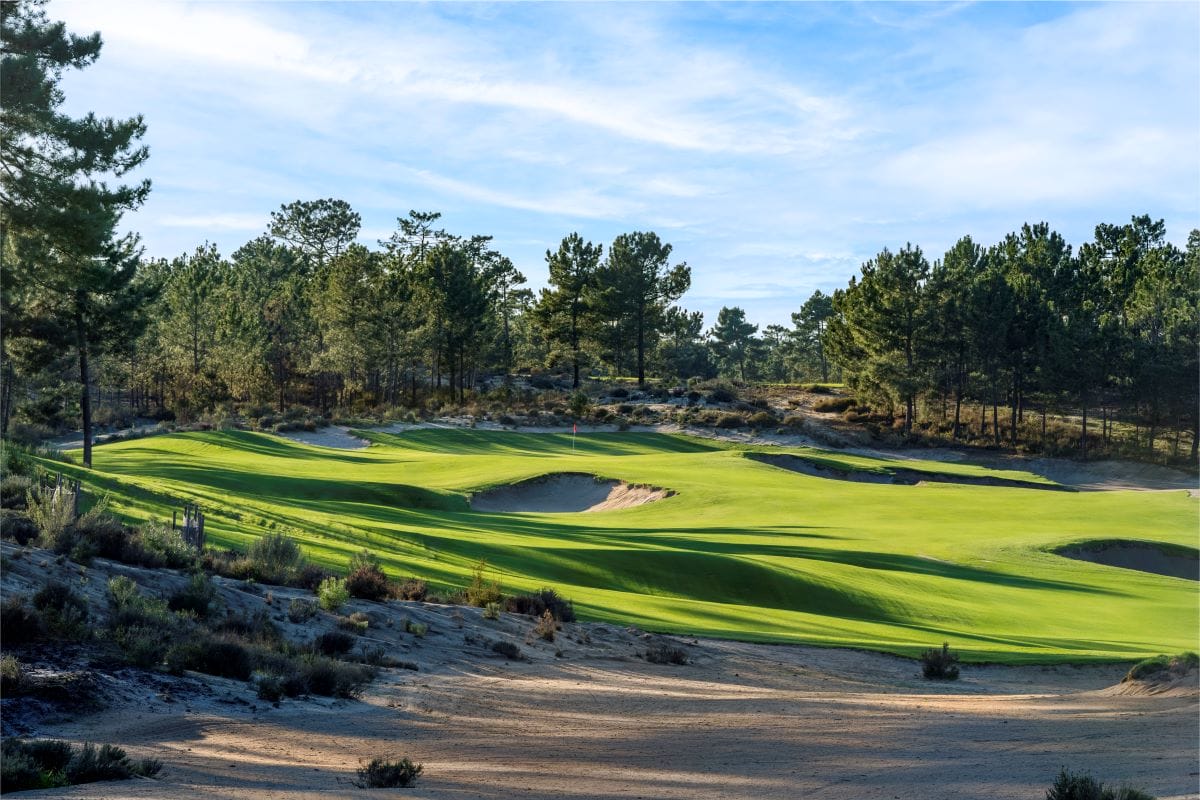The Portuguese capital is a thriving metropolis, one of the oldest cities in the world, and the hub of a once sprawling empire that controlled maritime trade between Europe and most of the world, and if you’ve got the clubs and 72 hours in Lisbon, here’s what you should do.
While The Algarve’s popularity among Irish golfers and sun holiday makers speaks for itself, there is much more to Portugal than just its southern coast and nowhere is that more evident than the nation’s capital and surrounding areas.
The city itself somehow flies under the radar when compared to other big name European destinations like Barcelona, Paris and Rome, but there are benefits to this and though there are still tourists aplenty, the relative lack of gimmickry and tourist traps are a very welcome diversion, and it’s also reasonably priced in comparison.
Lisbon is built on seven hills, meaning that walking the streets can be a little taxing on the calves, but the result is a variety of elevated views. Plus, you can hop on and off the trams and the downtown region is on the flatlands alongside the Tagus estuary.
With such a long seafaring history, it’s no surprise that seafood is extremely popular and the city has some of the best cuisine you’ll find. If you’ve yet to develop a palate for shellfish, squid, octopus and a wide variety of other marine fare, there’s no better place to broaden your horizons.
Celebrity chef José Avillez has no fewer than seven restaurants dotted around the city, with themes varying from vegetarian at Encanto, seafood at Maré, and international flavours at Cantinho do Avillez, while Mini Bar is a dining and theatrical experience with each course representing an act in a play and the waiters the de facto cast.
For nightlife, the Intendente neighbourhood has been transformed from a once seedy and crime-ridden black spot to a hip and thriving community with vibrant cafes and bars with a wide variety of DJs and live music options.
Depending on the time of year, you may be able to take in a football game at Benfica’s Estádio do Sport Lisboa or the neighbouring Estádio José Alvalade where Sporting play and witness the colourful and fanatical supporters in their natural habitats.
Other must-see tourist attractions include the Tower of Belem, a Unesco World Heritage site, which was built in the late 15th and early 16th centuries at the mouth of the Tagus River to defend the city against marauders from sea. It was the ceremonial gateway to Lisbon which saw off and welcomed back the explorers whose courageous voyages of discovery helped create the dynasty that Renaissance Portugal became.
And of course, when it comes to golf courses in the Lisbon and central Portuguese region, you’re spoiled for choice as well.

The Dunas Course at Terras da Comporta
Green Fees – Introductory rates from €100 but will rise in October to €175
An hour south of Lisbon, across the near 12-and-a-half kilometre Vasco da Gama bridge – the second longest bridge in Europe – is the seaside village of Comporta, memorable for many reasons including the rice paddies that line the coast, the huge storks who make their nests on the electricity pylons that line the roads, and with the recent opening of the Dunas Course, memorable for incredible golf.
Designed by Scottish architect David McLay-Kidd, best known for his Oregon masterpiece Bandon Dunes and our own Powerscourt West, The Dunas Course was a long time coming. Situated next to the Sado Estuary Nature Reserve, work first began in 2008 but hit the skids in 2009 in the midst of the global recession before work recommenced in 2012. The course was nearing completion when the Espirito Santo Bank collapsed in 2014, causing another cessation. Six long years followed, and when Vanguard Properties took ownership just before the global pandemic, the course had deteriorated almost beyond recognition.
But McLay-Kidd returned, the course was rescued and finally opened to the public in June, and the result is one of the finest golf courses you’ll find anywhere in Europe.
The course is the centrepiece of a development that will eventually comprise 250 villas and two five-star hotels, all of which will be constructed from wood to blend seamlessly into the natural surroundings, but at present, it’s just the golf course and that’s all the reason you need.
Built on sand-belt like terrain, the Dunas Course is nothing short of breath-taking. Each hole is visually stunning and a true joy to play. McLay-Kidd is quick to point out that it’s not ‘links style’ but an actual ‘links course,’ and on a recent visit here I was fortunate enough to play several holes with the architect himself.
Genuinely one of the most enjoyable courses I’ve ever played, players of all levels will be able to truly enjoy the experience because it’s a course that offers extreme width off the tee, large waste bunkers either side of the beautifully shaped fairways and large pines beyond that you really have to be quite wayward to find yourself amongst.
For the accomplished player looking to score low, each hole has a ‘Tiger line’ that will offer the best chance of making birdie, but these are also fraught with danger, often asking to carry a bunker or navigate through a thin sliver of green.
Each hole has six tee box options, and the par-71 measures 7,268 yards off the back sticks and as little as 4,200 off the front, with the shortest tees requiring virtually no carry to put your ball on the fairway.
There are virtually no blind shots, and though there are considerable undulations throughout, there are no severe climbs asked of players who choose to walk, though a buggy is recommended for pace of play as there are several long walks between green and subsequent tee and they are included as standard with all green fees.
The four par-3s all vary in distance, meaning you will work through your entire bag and only the genuine big hitters will be taking on each of the three par-5s in two.
Such is the quality, it’s hard to narrow it down to specific standout holes, but the par-4 13th is one. Playing from an elevated tee, the fairway narrows continuously with the waste area encroaching to offer a 20-yard driving lane before opening again approaching the green.
The course is built with sustainability and longevity at the forefront, and all the scrub vegetation is natural requiring no additional irrigation and with only the sea beyond, all water collected and used on the golf course was destined for the Atlantic Ocean.
Construction work on the clubhouse which overlooks the 18th green is underway, with an academy planned to complement the spectacular downhill driving range and enormous and heavily-sloped short-game and putting greens, and when complete, the cost of green fees are sure to rise, but at present the value is incredible for what will surely become one of the most highly-rated courses in all of continental Europe.

Green Fees – From €75
Situated just north of Comporta on the narrow Tróia Peninsula, the village can also be accessed via a short ferry crossing from Setubal which is within the Lisbon metropolitan area or by road through Comporta itself.
Designed by Robert Trent Jones Sr., Tróia opened in 1980 and flows through a mixture of dunes, umbrella pines and sandy waste areas, and in keeping with the characteristics of Trent Jones’ design, features bold bunkering, doglegs aplenty and relatively small, raised putting surfaces.
Whereas the Dunas Course is friendly off the tee, Tróia is anything but so you’d be wise not to be too gung-ho in selecting your tee boxes. When it hosted the Portuguese Open in 1983, eventual winner Sam Torrance was the only player to break par for the championship which speaks volumes about the challenge presented, but that doesn’t mean that you can’t have a lot of fun playing here.
The middle stretch of the opening nine, which plays along the Atlantic coastline, offer outstanding panoramic ocean views and the par-4 third hole in particular, which Trent Jones himself deemed to be among the top holes he’d ever created, is as scenic and beautiful a hole as you can possibly imagine.
Ranked number eight in Golf World’s top 100 courses in Continental Europe in 2019, Tróia’s setting means that wind tends to be a significant factor, which of course adds to the challenge, as does Trent Jones’ habit of placing trees in the fairways on occasion.
This is a very pleasant course to walk, and though buggies are available of course, they are not essential and the proximity of tee boxes to greens allow for a wonderful natural rhythm to the round, and the closing par-5, which doglegs towards a small green heavily guarded by bunkers offers both the opportunity for a grandstand finish or to be a scorecard wrecker. The Dunas Course’s arrival means that Tróia is likely to live in its shadow, but it’s definitely worth including on the itinerary and is very reasonably priced.
Green Fees – From €75 inc. buggies
Located just south of Lisbon between Sesimbra and Setubal, Quinta do Peru is very different to the Dunas Course and Tróia and is set in a 300-acre pine forest with the Arrabida Mountains as a backdrop. Designed by American Rocky Roquemore in 1994, the owners have declined to have any meaningful residential development on site meaning that the natural beauty of the forest accompanies you throughout.
Primarily a members’ club, tee times are still easily bookable through the club’s website and the quality of both the course and the conditioning are first class.
Water only comes into play once on the front nine, but appears much more frequently on the back, and it’s an extremely enjoyable course to play from start to finish.
At 6,600 yards off the back and a par of 72, it’s not a long course and the wide fairways allow you to open your shoulders on the tee, though particularly wayward shots are harshly punished.
The par-5 13th hole is one of the best holes on the course and plays downhill with a stream cutting across the fairway which veers left towards the green, and unusually for a par-5, is rated as one of the toughest holes on the course.
The par-3 16th is arguably the standout hole though, playing almost entirely over water and asking for a mid-to-long iron shot off most players.
While Quinta do Peru may not have the same breath-taking scenery as Tróia nor the potential to be one of the continent’s best like the Dunas, it’s the ideal third option for a three-day golfing trip to Lisbon.
























Leave a comment